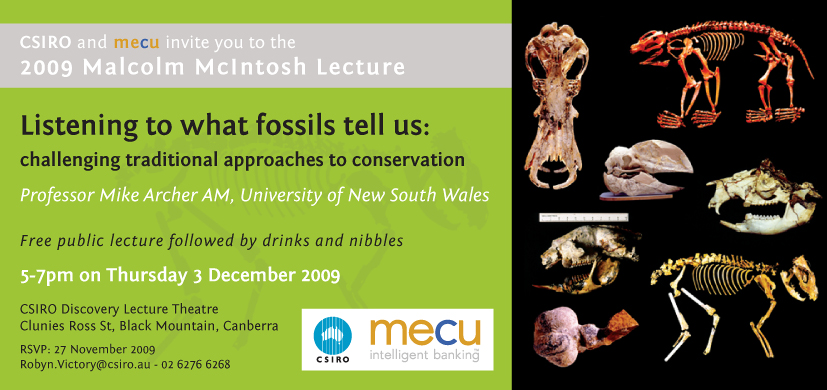Hi All,
Ian and I have been chatting about the Dromornis stirtoni skull (the giant
Miocene bird skull) pictured on the invite to the fossil talk (Listening to
what fossils tell us: challenging traditional approaches to conservation. Mike
Archer) sent around by Tony Lawson.
I have attached this morning’s reply
to Ian as it may be of interest to others on the chat line. As I mentioned in
an earlier email to Ian, I have no real knowledge of Miocene fossils so I had
to seek out most of the information attached below.
Cheers Dan
Ps Thanks Tony for alerting us to this
talk
---------------------------------------------------------------
Hi Ian
Sorry, ran out of time to reply yesterday.
I called Jared Archibald (the fossil preparator and taxidermist at the NT
Museum) to chat to him about what their pervious NT Museum palaeontologists had
thought about Dromornis stirtoni (DS). Jared has spent as much time as anyone
digging out these fossils and chatting to the Palaeos about them. There is
currently no palaeontologist at the NT Museum but I know they are hoping to get
funds together to employ someone in the near future. Fingers crossed they can,
as the Alcoota and Bullocky Creek digs they manage are important Miocene fossil
sites.
Apparently their group still consider DS to be foremost a herbivore but would not
be able to exclude some scavenging. Jared was saying they would dig out a hundred
if not thousands of Dromornis spp.
bone fragments (largely leg bones) for every fossil crocodile, thylacine, or
goanna bone they found. So their abundance is not typical of that of a large
predator and almost certainly too high also for a primary large scavenger. But
not to say it would never have scavenged.
The other points he reinforced were the
lack of raptorial hook, the toe bones being most similar to Emu/Ostrich toes
(so not adapted for ripping, tearing, or slicing) and the lack of claws on the
wing. Apparently the rear of the skull is extremely similar to that of a Magpie
Goose, not that this in itself would mean anything about the DS diet but does reinforce the close
relationship to Anseriformes.
The argument for a carnivorous habit
obviously stems from the large bill. Apparently Stephen Wroe has done much of
the research on this and concluded that the large head and neck muscles associated
with such a large bill would be adapted for meat eating. He concludes the large
bill and muscles would represent a gross case of ‘over-design’ in
nature - to purely crack the largest or hardest nuts. Nature rarely allows for
over-design.
Wroe, S.
(1999). The
bird from hell? Nature Australia, 26: 58-64
Wroe, S.
(1998). Bills, bones and bias: did Thunder Birds eat meat? Riversleigh Notes, 40: 2-4.
From a quick read of the first article
listed above, Stephen Wroe’s arguments for ‘over design’ of
the bill for plant or nut eating seem pretty sound to me. But I would want to know
a bit more about the palaeoecology/environment of the region during the
Miocene. Again not something I am at all well read on. In particular, I would
want to know what the abundant plant types were. I am sure this is pretty well known
or has been worked out for the north Australian latitude in the Miocene. If
there was something similar to an oversized reed (say a bamboo with nutritious
inner pulp) that could possibly explain the large bill and bill design then I
don’t see why DS might not
have used its large bill in a manner similar to a Purple Swamphen. It certainly
reminds me of an oversized Purple Swamphen bill and they are very well adapted
for carefully stripping away reeds and other aquatic plants and roots to the
nutritious parts. But equally they wouldn’t pass up a tasty young bird,
small mammal or frog either!
The book supporting the herbivore
hypothesis is called ‘The Magnificent Mihirungs’. I think by Peter
Murray and Pat Vickers-Rich - both palaeontologists. Peter Murray did much of
the NT Museum work on the Dromornis
spp. and Bullockensis sp. (?spelling)
and I think Pat Vickers-Rich originally described DS. But don’t quote me on that.
So not sure which side I find more
convincing, but it seems like it is still divides opinion. Possibly, DS was a bit opportunistic and fed on both
plants/nuts and meat.
Cheers Dan
Dr Daniel Mantle
Timescales Project
Geoscience Australia
Ph. +61 (2) 6249 5831 (work)
m("ga.gov.au","daniel.mantle");">
From:
Tony Lawson
[
Sent: Thursday,
26 November 2009 10:59
To:
Subject: [canberrabirds] Fw:
Invitation to the 2009 Malcolm McIntosh Lecture
This may be of interest to some - it looks like a fossil of a
bird's beak in the illustration.


